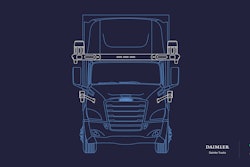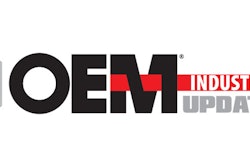
Daimler Truck is developing a scalable autonomous truck platform that is perfectly suited for SAE Level 4 autonomous driving, including redundancy systems needed to achieve safe and reliable operations. The four key areas with a redundant architecture are the braking system, the steering system, the low voltage power net and the network communications. In case that any of the primary systems encounter a fault, the Level 4 vehicle will be able to monitor, assess and deploy its backup systems to control the truck safely.
Daimler Truck’s L4 truck platform is based on Freightliner’s Cascadia and aims to set new industry standards. The unique redundant truck chassis is being developed for Waymo Via based on their specifications. A first version of the truck has already been delivered this year for integration of the Waymo Driver, the autonomous driving system. If a fault is deemed critical to the operation of the vehicle, the autonomous driving system will allow the truck to follow a safety protocol and be able to execute a “minimal risk maneuver” to come to a safe stop.
Dr. Peter Vaughan Schmidt, Head of Autonomous Technology Group at Daimler Truck: “Every smart autonomous driving system needs a strong foundation: our Level 4 vehicle platform based on the Freightliner Cascadia is ideal for integration of autonomous software, hardware and compute. It can significantly contribute to enhancing safety in traffic thanks to its redundancy of systems and a multitude of sensors. It brings us much closer to our vision of accident-free driving.”
 Level 4 Autonomous Freightliner CascadiaDaimler Trucks North America LLC
Level 4 Autonomous Freightliner CascadiaDaimler Trucks North America LLC
The redundant system architecture
More than 1,500 new and unique requirements have been identified by Waymo Via. The engineering team at Daimler Trucks North America LLC (DTNA) is developing and implementing these requirements during the vehicle development process. For example, while current pneumatic braking systems have fail operational attributes, Daimler Truck’s Level 4 vehicles have an additional layer of electronic redundancy, using two electronic control units (ECU) – a primary and a secondary system. Together, they ensure full brake performance, to safely execute a minimal risk maneuver in case one system is not operating properly.
The same logic applies to the steering system that has been enhanced by having two servo motors. In case of an electronic or hydraulic failure, the backup servo motor also receives the requested steering angle from the autonomous driving system and can react accordingly.
Constant communication between these key systems ensures that there is no loss of critical information flow among the controllers. Daimler Truck has included a secondary communication network to key devices, which is also protected by cyber security requirements. As for the demanding power consumption by all the ECUs and sensors in an autonomous truck, a robust low voltage power net is required. Exclusively developed at DTNA, the power net system ensures constant energy flow to critical systems.
Scalable solution for Daimler Truck’s customers
In combination with a third party autonomous driving software, this redundant chassis offers customers full SAE Level 4 autonomous driving capabilities. As part of Daimler Truck’s dual track strategy, the truck manufacturer is working together with two strong autonomous technology partners, Waymo Via and Torc Robotics, offering multiple routes to commercialization. Daimler Truck has the capability to tailor and scale the Level 4 truck chassis to the autonomous driving specifications of both technology partners.
Daimler Truck in market leading position as demand grows - best testing conditions in the U.S.
According to the U.S. Bureau of Transportation Statistics, the U.S. has seen the tonnage of goods shipped by trucks increase by 56% in the past decade. This number is expected to nearly double in the next two and a half decades. At the same time, the trucking industry faces a shortage of drivers. These developments contribute to a growing need for safe, reliable, cost-effective trucking solutions. DTNA’s role for the industry provides a unique position to safely develop and test automated truck technologies. Based in Portland, the team of experienced engineers at DTNA is responsible for developing, building and releasing the Level 4 vehicle platform with redundant systems in close collaboration with their partners. DTNA already reached a critical milestone towards series production and delivered a first version of the redundant Freightliner Cascadia built for L4 readiness to Waymo for integration of the Waymo Driver.
 Redundant Steering SystemDaimler Trucks North America LLC
Redundant Steering SystemDaimler Trucks North America LLC
Autonomous Technology Group – a global technology powerhouse for automated driving
Following the investment announcement in automated driving at the beginning of 2019, Daimler Truck established the Autonomous Technology Group. Daimler Truck’s global organization for automated truck driving brings together its worldwide experience and expertise. The Group takes responsibility for the overall strategy and implementation of the automated driving roadmap, including research and development, testing and validation and setting up the required operations infrastructure and network with the ultimate vision of series production of autonomous trucks (SAE level 4) within the decade. The Group has a global reach with experts working in various locations throughout the company’s worldwide development network.
Daimler Truck, the pioneer of automated trucks
Daimler Truck has years of experience in testing and validating the durability, reliability and safety of commercial vehicles around the world. In 2014, the world’s leading truck manufacturer presented the Mercedes-Benz Future Truck 2025, the world’s first automated truck, and was the first to demonstrate the technological opportunities and great potential that automated trucks offer customers and society. In 2015, Daimler’s Freightliner Inspiration Truck obtained the first-ever road license for a partially automated commercial vehicle demonstrating the promise of automated driving on the highways of Nevada. With Active Drive Assist (Mercedes-Benz Actros, FUSO Super Great) and Detroit Assurance 5.0 with Active Lane Assist (Freightliner Cascadia), Daimler Truck has brought partially automated driving features (SAE Level 2) into series production.
 Redundant Breaking SystemDaimler Trucks North America LLC
Redundant Breaking SystemDaimler Trucks North America LLC

















![Hcm Ax Landcros Press Release[32] jpg](https://img.oemoffhighway.com/mindful/acbm/workspaces/default/uploads/2025/11/hcmaxlandcros-press-release32jpg.mAEgsolr89.jpg?ar=16%3A9&auto=format%2Ccompress&fit=crop&h=135&q=70&w=240)